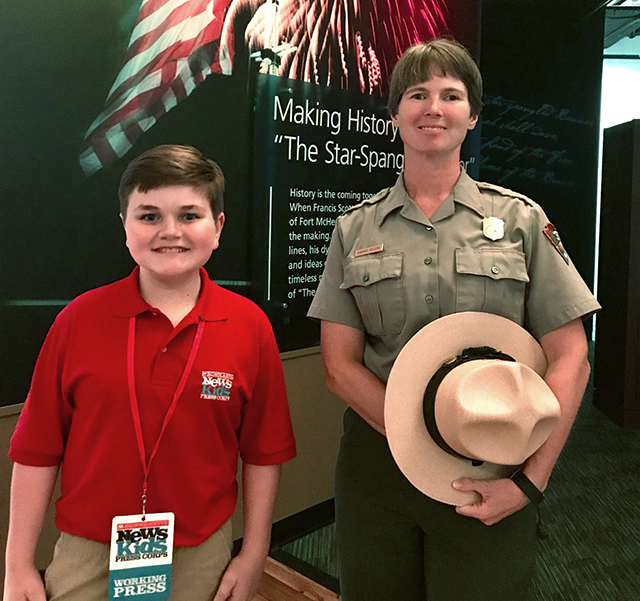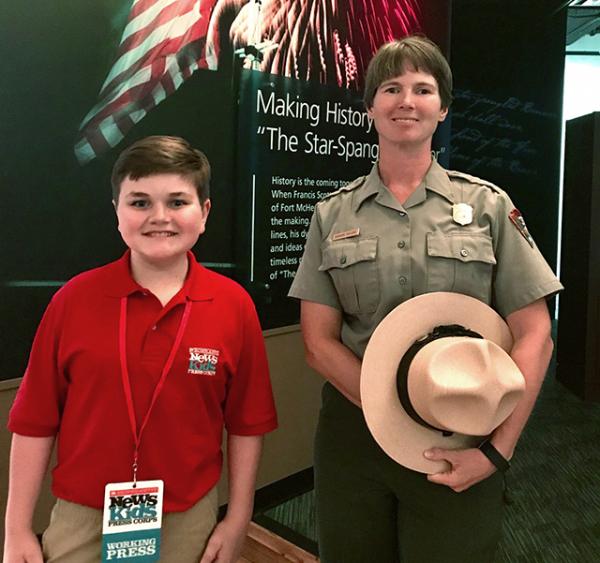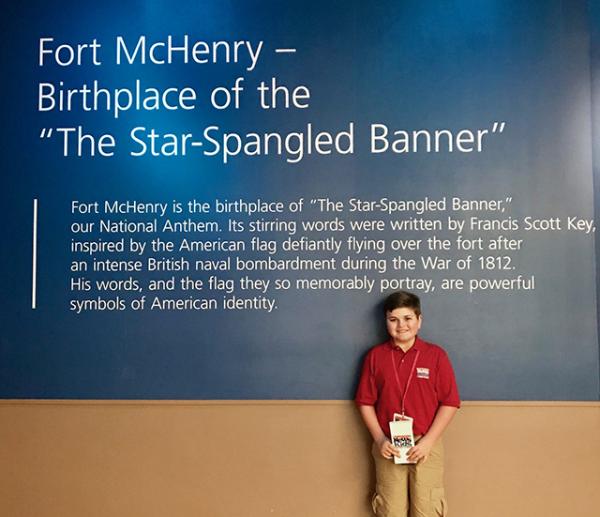KID REPORTERS’ NOTEBOOK
Birthplace of the National Anthem


Nolan at Fort McHenry with National Park Service Ranger Shannon McLucas
“The Star-Spangled Banner,″ the national anthem of the United States, celebrates the enduring symbol of the American flag.The song’s lyrics come from “Defence of Fort M′Henry,” a poem written by Francis Scott Key in 1814 after the Battle of Baltimore. The battle was part of the War of 1812, a conflict between the United States and the United Kingdom that lasted for nearly three years.
Key, who was an American lawyer and poet, was detained on a British ship during the battle. He had been on a mercy mission to free a U.S. doctor.
Early on September 14, 1814, Key spotted the American flag, known then as the Star-Spangled Banner. It was still flying over Baltimore’s Fort McHenry after the British attack.
To Key, this was a sign that the U.S., which had gained its independence in 1783, had not been defeated. “O! say, does that star-spangled banner yet wave,” he wrote. “O’er the land of the free, and the home of the brave?”

Nolan visits Fort McHenry National Monument and Historic Shrine in Baltimore, Maryland.
“BROAD STRIPES AND BRIGHT STARS″
During a recent visit to Fort McHenry National Monument and Historic Shrine in Baltimore, Maryland, I spoke with Park Ranger Shannon McLucas of the National Park Service.
The flag that had flown over Fort McHenry, McLucas explained, was 30 feet high and 42 feet wide. Each of its 15 “broad stripes,” as Key described them, was two feet high, its 15 “bright stars” measuring two feet from point to point.
George Armistead, an American military officer who served as commander of Fort McHenry, had ordered the flag made when Baltimore was bracing for the British attack.
“Armistead ordered the garrison [fortress] flag to be so large because he wanted the British to have no difficulty seeing it from afar,” McLucas said. At the time, it was one of the largest flags ever flown.
Mary Young Pickersgill, a Baltimore flag maker, was commissioned to create the flag. Her daughter, Caroline, and her nieces helped with the project. An African American indentured servant named Grace Wisher, who was 13 years old and learning the art of flag-making, also assisted Pickersgill. They spent six weeks sewing the flag by hand.
“A HISTORIC SHRINE″
“There is something special about Fort McHenry that appeals to Americans and helps them connect with history,” McLucas said.
Fort McHenry is both a national monument and a historic shrine. “It’s called a historic shrine because we hold a singular and unique place in American cultural history, being the home of ‘The Star-Spangled Banner,’” McLucas explained. “Marylanders weren’t content with just calling this a national monument. They pressed Congress to give Fort McHenry a dual designation.”
The song that grew out of Key’s poem did not officially become the national anthem until 1931. As for the original flag, it is on display at the National Museum of American History in Washington, D.C., in an environmentally-controlled case.
